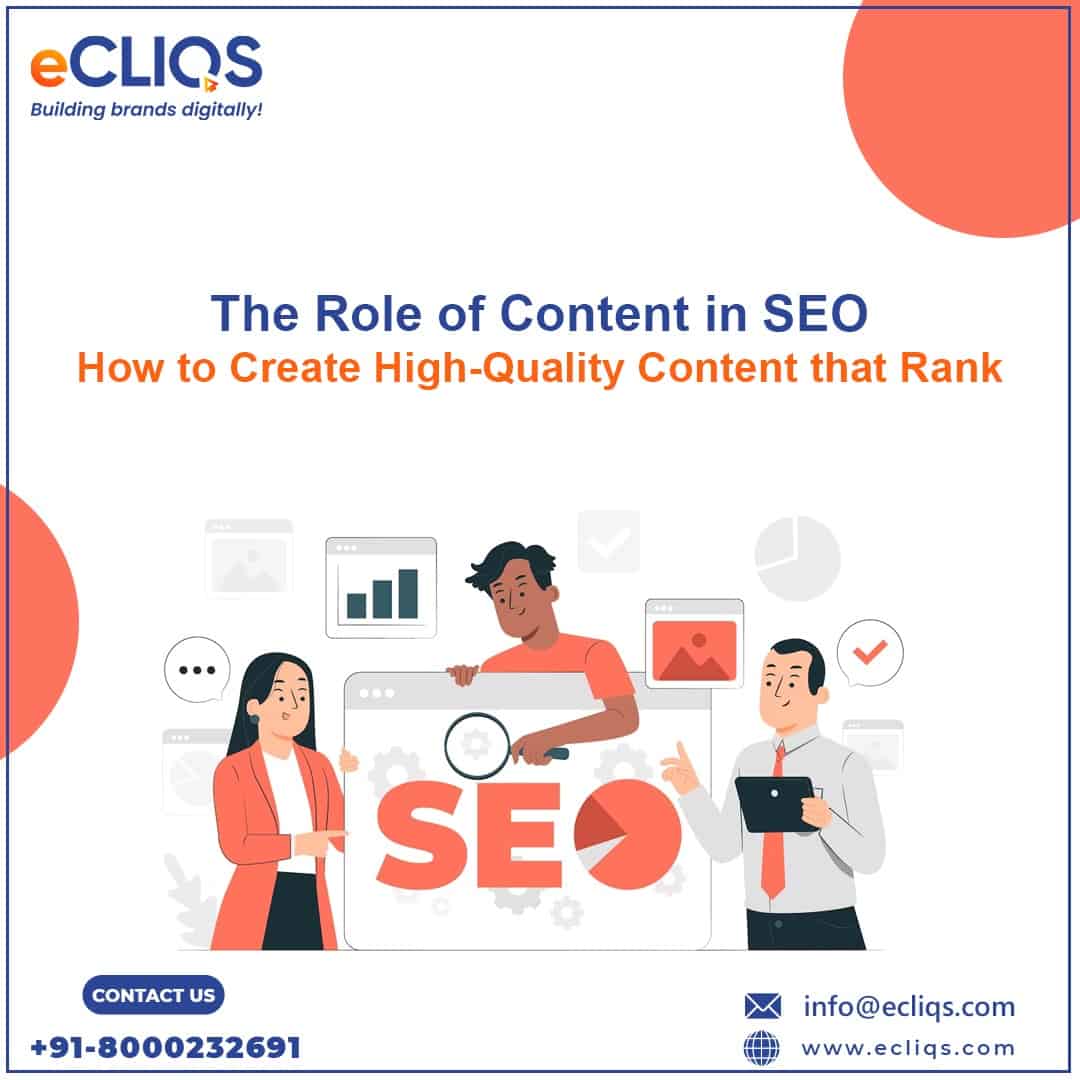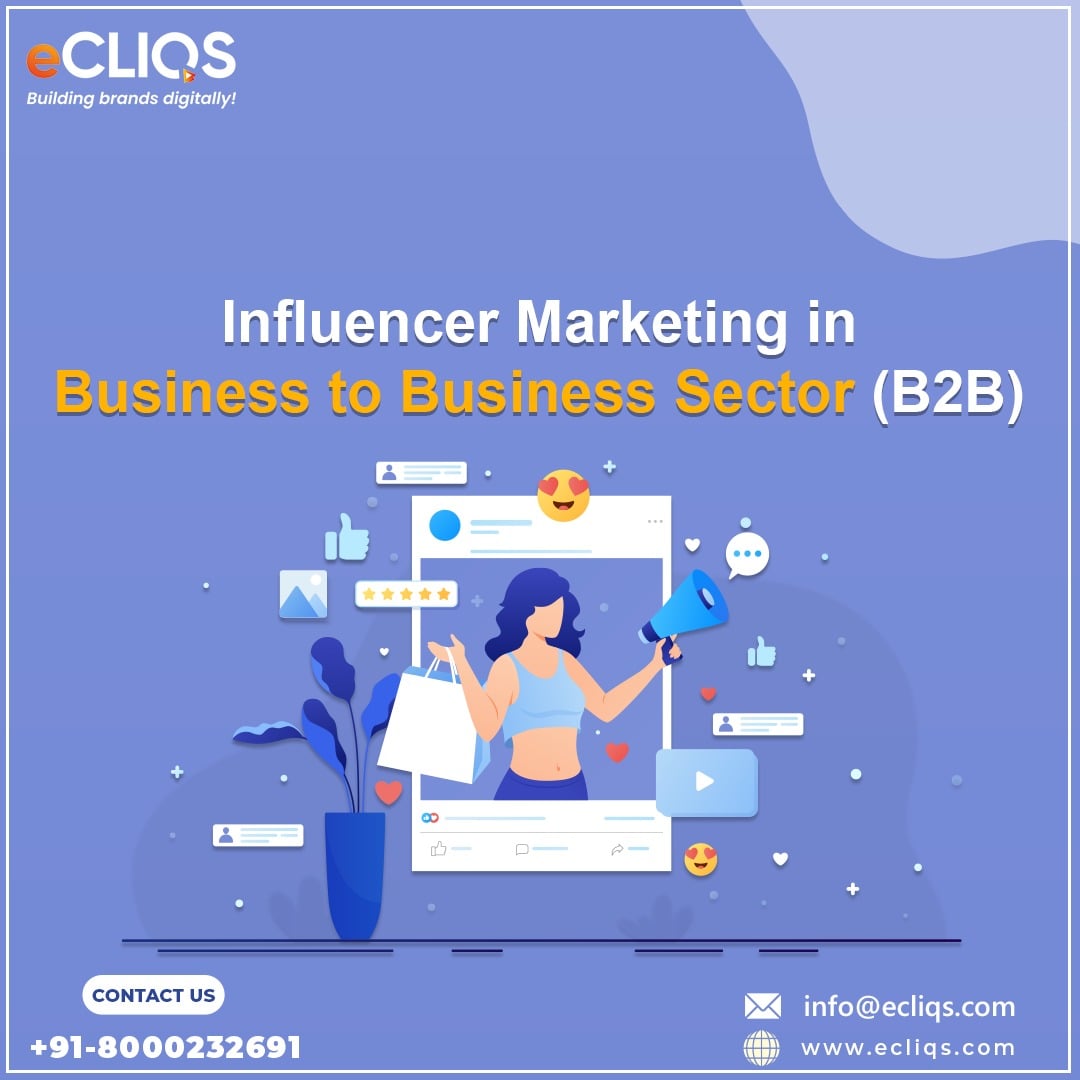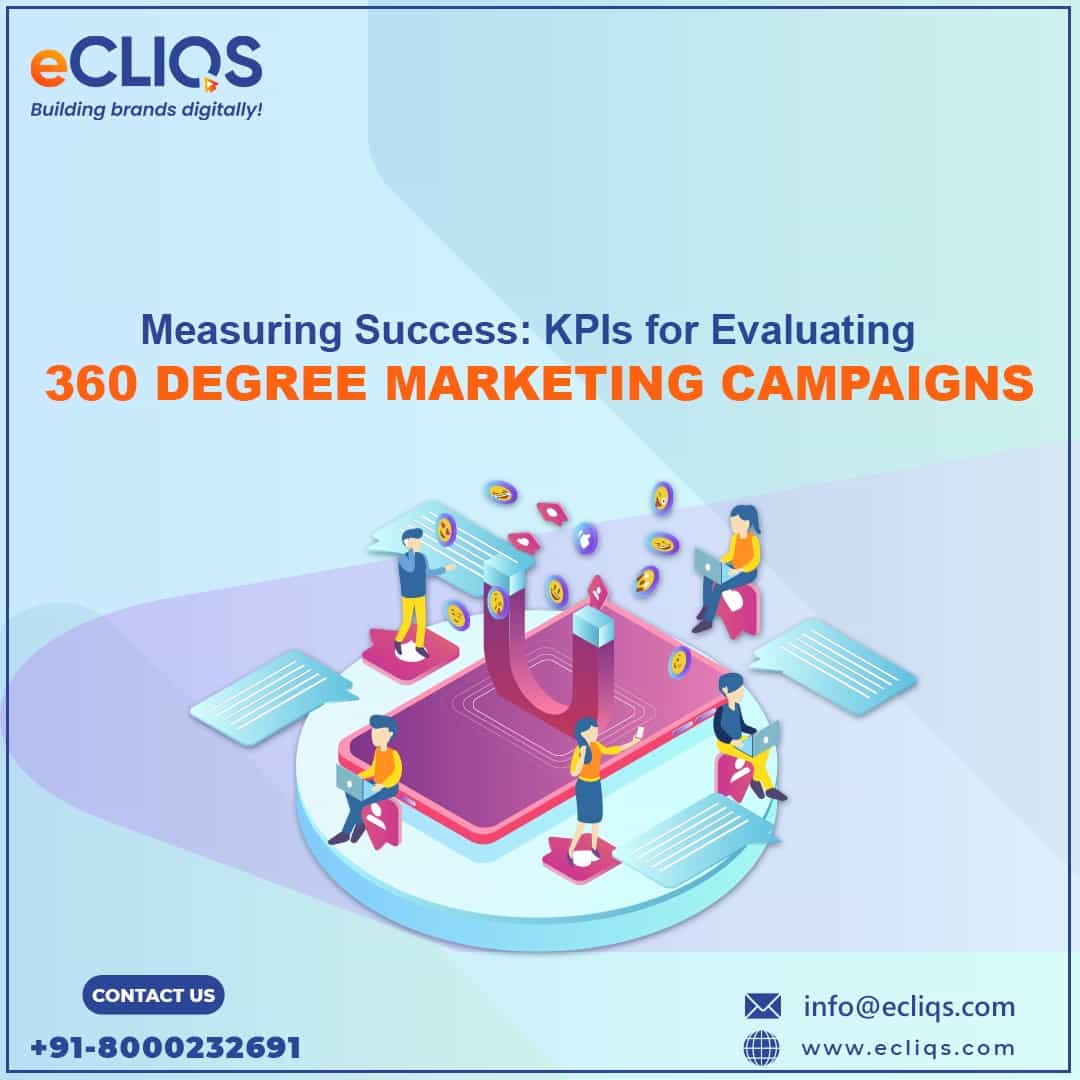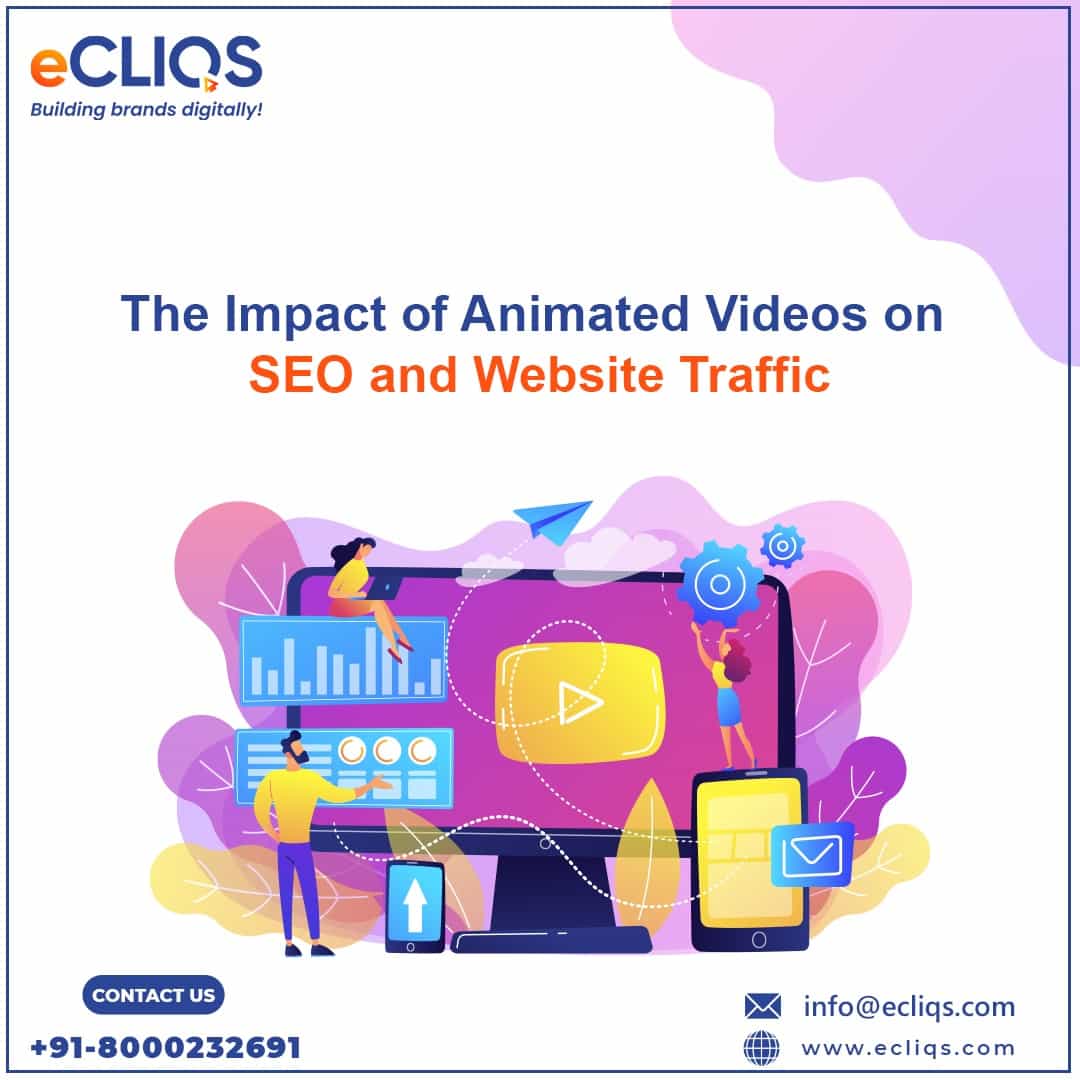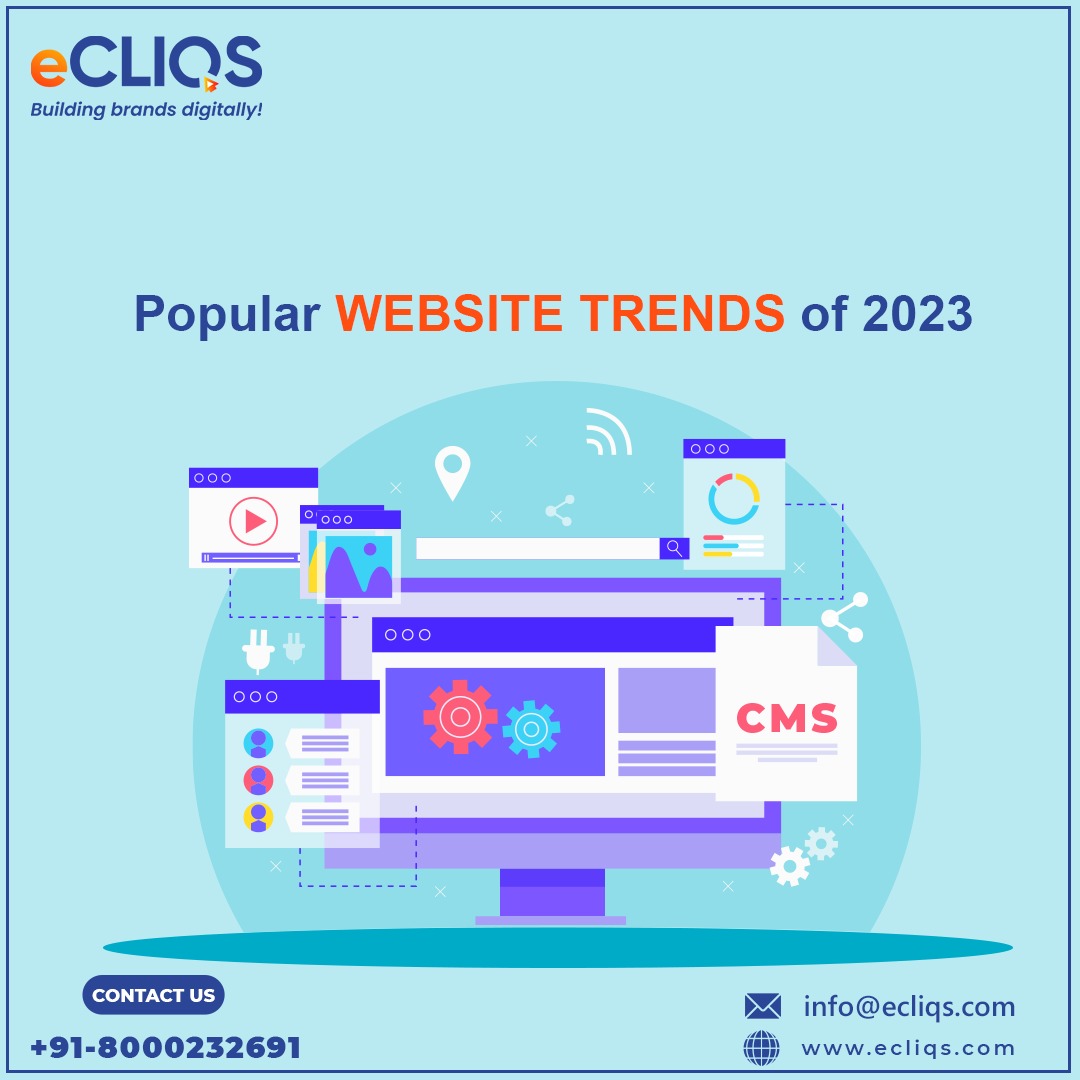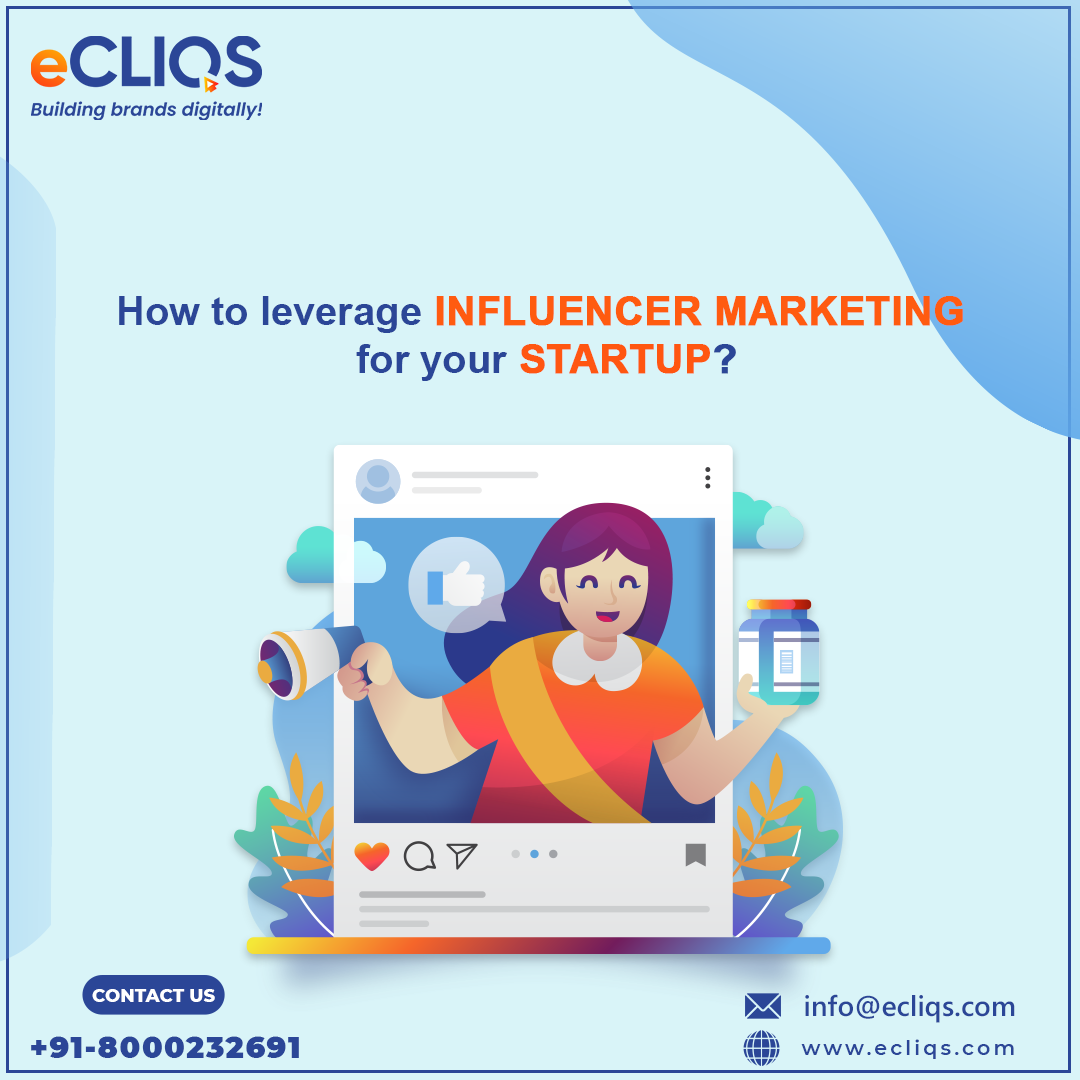The Importance of Brand Consistency in Social Media Marketing: How to Build Your Brand Identity
Your brand is the face of your company—what you show to potential customers. It not only shapes their first impression of your company and product, but it can also entice them to come back for more business. Maintaining brand consistency produces reliable results and can help form a solid foundation for your marketing strategies.
If you’re interested in learning more about brand consistency, read on. We’ll cover what brand consistency is, how it can help your business, and what you can do to achieve it.
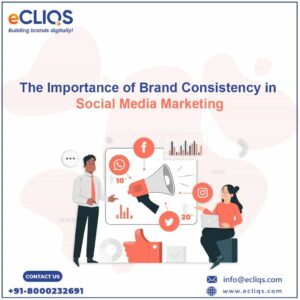
Understanding Brand Consistency:
Brand consistency is the art of presenting a unified and recognizable image across all platforms and interactions. From the visual elements like logos and color schemes to the tone of voice and messaging, consistency builds trust and fosters a sense of reliability among your audience.
The Importance of Brand Consistency:
- Building Recognition: Consistency reinforces visual and messaging elements, making your brand instantly recognizable amidst the sea of content on social media.
- Fostering Trust: A consistent brand image instills trust. When your audience knows what to expect, they are more likely to engage and build a lasting relationship with your brand.
- Creating Cohesion Across Platforms: Social media offers a variety of platforms, each with its unique features. Consistency ensures your brand message remains cohesive, whether it’s a tweet, a Facebook post, or an Instagram story.
- Enhancing Professionalism: A consistent brand image portrays professionalism. It shows that your brand is intentional and invested in delivering a polished and coherent experience.
- Differentiating from Competitors: In a competitive landscape, consistency helps your brand stand out. A cohesive and distinct brand identity gives you a competitive edge by making your brand more memorable.
Strategies for Building Brand Consistency:
- Establish Brand Guidelines: Clearly define your brand guidelines covering elements such as logo usage, color palettes, typography, and tone of voice.
- Create a Content Calendar: Plan your social media content in advance. A content calendar ensures that your messaging is strategic, aligned with your brand, and consistently delivered.
- Visual Consistency: Use consistent visuals across platforms. This includes imagery, filters, and design elements that reflect your brand’s personality.
- Maintain a Unified Tone: Whether your brand voice is friendly, professional, or witty, maintain a consistent tone across all communications. This includes captions, replies, and content descriptions.
- Engage Authentically: Authenticity is key. Engage with your audience in a way that aligns with your brand identity. Respond to comments and messages consistently, and be genuine in your interactions.
Conclusion
Maintaining brand consistency on social media is crucial for businesses that want to create a strong brand image and increase brand recognition. Consistent branding helps establish brand trust, create a cohesive brand experience, improve marketing efficiency, and increase brand loyalty. If you’re looking to improve your social media marketing, be sure to prioritize brand consistency across all social media channels.
The Role of Content in SEO: How to Create High-Quality Content that Rank
There is no doubt that your company requires a strong internet presence to thrive these days. This is where your SEO efforts come in
Search engine optimization is crucial for increasing a website’s visibility and boosting organic traffic. Let’s look at why content is vital for SEO and how it may assist organizations reach their online objectives.
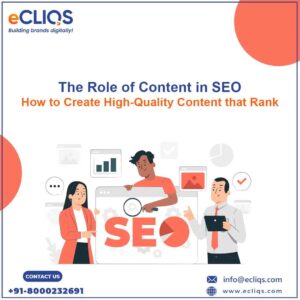
Key Elements of High-Quality Content
- Relevance is Key: Content should be tailored to meet the needs and interests of your target audience. Understanding your audience’s search intent allows you to produce content that directly addresses their queries and concerns.
- Comprehensive and Informative: High-quality content goes beyond surface-level information. Aim to create comprehensive and informative pieces that provide value to your audience. This not only establishes your expertise but also keeps visitors on your page longer, signaling to search engines that your content is valuable.
- Keyword Optimization: While keyword stuffing is outdated and frowned upon, strategic keyword optimization remains crucial. Identify relevant keywords and integrate them naturally into your content. This helps search engines understand the context of your content and improves its visibility for specific queries.
- Engaging and Readable: User experience matters. An engaging and readable format not only keeps visitors on your page but also signals to search engines that your content is user-friendly.
- Authority and Credibility: Establishing yourself as an authority in your field is vital. Back-up your content with credible sources, cite references, and showcase your expertise. Search engines reward content that demonstrates authority, reliability, and trustworthiness.
Strategies for SEO-Friendly Content Creation
- Conduct Thorough Keyword Research: Start by identifying relevant keywords for your industry and audience. Tools like Google Keyword Planner and SEMrush can help you uncover valuable insights into search volumes and competition.
- Create a Content Calendar: Plan your content strategy in advance by creating a content calendar. This not only ensures consistency but also allows you to align your content with seasonal trends, industry events, or product launches.
- Optimize On-Page Elements: Pay attention to on-page SEO elements such as meta titles, meta descriptions, and header tags. These elements provide search engines with essential information about the content and contribute to better visibility.
- Prioritize User Experience: A seamless user experience is crucial for SEO. Ensure that your website is mobile-friendly, optimize page loading times, and create a clear and intuitive navigation structure.
Conclusion
It is obvious that improving your content can significantly raise your visibility and chances of reaching your target audience. If your material is not visible, it may go undetected and fail to generate interaction or leads.
However, by adopting the SEO tactics outlined above, such as writing unique meta descriptions and adding keywords, you can enhance your content’s visibility in search engine results and attract more visitors.
Increasing visibility and exposure with optimized content takes time and work, but the benefits are well worth it. Businesses can increase their online presence and reach their target audience by committing to providing high-quality, optimized content.
Why Website Speed Matters and How to Improve?
Website speed, or website performance, refers to how quickly a browser is able to load fully functional web pages from a given site. Poorly performing sites that render slowly in a browser can drive users away. Conversely, sites that load quickly will typically receive more traffic and have better conversion rates.
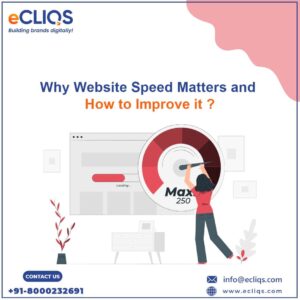
Why Website Speed Matters:
- User Experience (UX): A slow-loading website frustrates visitors and can lead to a high bounce rate. Users expect instant gratification, and a delay of just a few seconds can significantly impact their perception of your brand. A smooth and swift user experience is essential for retaining and converting visitors into customers.
- Search Engine Rankings: Search engines, particularly Google, consider website speed as one of the ranking factors. Websites that load quickly are likely to rank higher in search results. Google’s algorithm values user experience, and fast-loading pages contribute positively to your site’s SEO, potentially increasing your visibility and organic traffic.
- Mobile Responsiveness: With the majority of internet users accessing websites through mobile devices, mobile responsiveness is paramount. Slow-loading pages can be especially frustrating for mobile users, leading them to abandon the site. Google’s mobile-first indexing also emphasizes the importance of a fast and mobile-friendly website.
- Conversion Rates: Website speed directly impacts conversion rates. Studies have shown that even a one-second delay in page load time can result in a significant drop in conversions. Whether you’re selling products, services, or aiming for newsletter sign-ups, a fast website is crucial for encouraging users to take the desired actions.
What factors affect site speed?
- Page Weight: The resources required for website loading significantly affect performance. As web technologies advance and websites become more complex, maintaining a light website (with small file sizes and fast-loading pages) is increasingly challenging.
- Network conditions: Even if a website is designed to be lightweight, it may not load quickly in browsers due to network slowness. The local networking equipment used and the quality of the ISP’s services impact network connectivity. Additionally, mobile devices using 3G or 4G instead of connecting to the Internet over WiFi will typically have slower network connections.
- Hosting Location: If content has to travel a long way to arrive where it is needed, this results in a high amount of network latency. For instance, if a website’s HTML and CSS files are hosted in a data center in Delhi, and its images are hosted in a data center in Kashmir, a user will have to wait while all of these files travel thousands of miles to their device.
Tips to improve website speed:
- Optimize pages: Images often take the longest to load on a website since image files tend to be larger in size than HTML and CSS files. Luckily, image load time can be reduced via image optimization, which typically involves reducing its resolution and dimensions, and compressing the image file itself.
- Limit the number of HTTP requests: Webpages usually prompt browsers to make numerous HTTP requests for assets like images, scripts, and CSS files. This process involves round trips to the server, contributing to the overall load time. To mitigate these issues, it’s crucial to minimize the number of assets per page. Conducting a speed test can pinpoint which HTTP requests are causing delays.
- Limit use of external scripts: Any scripted web page elements that are loaded from somewhere else — such as external commenting systems, CTA buttons, CMS plugins, or lead-generation popups — need to be loaded each time a page loads. Depending on the size of the script, these can slow a webpage down, or cause the webpage to not load all at once
- Limit redirect usage: A redirect is when visitors to one webpage get forwarded to a different page instead. Redirects add a few fractions of a second, or sometimes even whole seconds, to page load times. Website owners should institute clear guidelines on redirect usage and periodically scan important web pages for unnecessary redirects.
Conclusion: As we look forward, one thing is clear: optimizing your page speed is necessary for the future. As Google continues to reward mobile-friendly sites with a positive page experience, your SEO focus should be on improving your page speed.
Influencer Marketing in Business to Business Sector (B2B)
As B2B marketing grows, businesses are learning how influencer marketing may assist enhance brand awareness, reputation, and income. According to an InvespCro research, 94% of marketers agree that influencer marketing is a good strategy for B2B organizations.
Despite this, just 24% of B2B companies use influencer marketing in their overall company strategy.
That’s right; influencer marketing isn’t just for B2C brands anymore. Let us dive into the realm of influencer marketing in B2B.
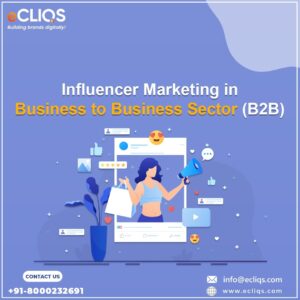
The B2B Landscape is Changing
Traditionally, B2B marketing was a realm of data sheets, whitepapers, and serious corporate talks. While these aspects remain crucial, the landscape has evolved. Decision-makers and professionals now spend more time online, engaging with content and influencers in their respective industries. This difference in era has created an opportunity for influencer marketing to make its way into the B2B space.
What is B2B Influencer Marketing?
B2B influencer marketing involves collaborating with industry experts, thought leaders, or professionals who have a substantial online following and influence.
These influencers are creative and resonate the most with their audience. They know their audience the best and know ways to make your product into their hearts.
Why B2B Influencer Marketing Matters?
Credibility and Trust: Influencers in the B2B realm are trusted voices within their industries. Their endorsement can lend credibility to your brand and its offerings.
Reach and Visibility: Influencers have dedicated audiences interested in niche topics. Partnering with them allows your brand to tap into these audiences and gain visibility among your target demographic.
Quality Content: Influencers are skilled content creators. Their collaboration ensures a high engagement rate, informative content in the most creative way, and a shortcut for you to gain audience trust.
Lead Generation: An effective influencer marketing strategy can drive qualified leads to your business. Influencers can help you reach decision-makers who may not have been easily accessible through traditional marketing channels.
Networking Opportunities: Building relationships with influencers can lead to valuable networking opportunities within your industry. These connections can open doors to partnerships, collaborations, and business growth.
Getting Started with B2B Influencer Marketing
Identify the Right Influencers: Look for influencers who align with your industry, values, and target audience. They should have an interest in your industry and should be close with their followers.
Set Clear Goals: Determine what you want to achieve with your influencer marketing campaign. Whether it’s brand awareness, lead generation, or thought leadership, clear goals are essential.
Collaborate Authentically: Encourage influencers to create content that genuinely reflects their opinions and experiences with your brand. Authenticity is key to building trust.
Measure and Analyze: Track the performance of your influencer marketing efforts using relevant metrics like engagement rates, lead generation, and conversions.
Maintain Relationships: Building long-term relationships with influencers can lead to sustained success. Keep the lines of communication open and collaborate on multiple campaigns.
Summary
Businesses must maintain the value of influencer marketing in B2B. Because customers place a great value on influencers, they must adopt this marketing strategy to boost their brand’s visibility, reputation, and sales.
Influencer marketing is a growing concept that will continue to grow as more businesses adopt it. To construct successful programs, businesses must establish precise objectives for their influencer marketing activities and measure their efficacy.
Measuring Success: KPIs for Evaluating 360 Degree Marketing Campaigns
Metrics for marketing analytics are critical for having access to relevant data that can enhance sales, profitability, and brand recognition. The correct analytics tools can assist in the identification of new markets, audience segments, and possible growth regions.

However, with so much data available, it can be difficult to make sense of it all. It is vital to focus on specific metrics and key performance indicators (KPIs) while quantifying data. While these terminologies may appear perplexing at first, with a basic grasp, they become strong marketing tools.
1. Website Traffic and Engagement:
- Unique Visitors: It is the number of distinct individuals who visit your website. With the help of this, you can get insights on how many people have visited your website and if you are making any progress.
- Page Views: Tracks how many pages a visitor views per session. With this you will be able to understand your audience better in what products they are most interested in.
- Bounce Rate: Measures the percentage of visitors who leave the site after viewing only one page. A lower bounce rate suggests higher engagement. With the help of this, you will understand what corrections to make to your website.
2. Social Media Metrics:
- Follower Growth: Indicates how well your campaign is attracting a broader audience. Increase in follower growth marks increase in the content consumption by your audience.
- Engagement Rate: Calculates the ratio of interactions (likes, comments, shares) to the number of followers. High engagement rate indicates that your audience is actively engaging with your content and wants to see more of it.
- Click-Through Rate (CTR): Measures the percentage of clicks on a post or ad relative to its impressions. High click through rate indicates more people interested into your product.
3. Content Performance:
- Time on Page: Evaluates how long visitors stay on your content. Longer durations may signify quality content. The more time your audience spends on your page or website, the more they are likely to buy your products or services.
- Conversion Rate: Tracks how many visitors take a desired action, such as signing up for a newsletter or making a purchase.
4. Email Marketing Metrics:
- Open Rate: Measures the percentage of recipients who opened your email. More open rates indicates that your newsletter is engaging and your customers are hooked on your content.
- Click-Through Rate (Email CTR): Tracks the number of clicks on links within your email relative to the total number of recipients.
- Conversion Rate: Evaluates how many recipients completed the desired action after clicking through from an email. High conversion rate means your audience responding to a certain Call To Action mentioned in the email. It might be sign up or completing a pending purchase.
5. Search Engine Metrics:
- Organic Search Traffic: Analyzes how many users find your website through search engines.
- Keyword Rankings: Monitors your website’s position in search engine results pages (SERPs).
- Conversion from Organic Search: Measures the number of conversions generated from organic search traffic.
6. Customer Lifetime Value (CLV):
- Estimates the total revenue a customer is expected to generate throughout their relationship with your brand. High CLV suggests a strong campaign impact on customer retention.
7. Return on Investment (ROI):
- Evaluates the financial success of your campaign by comparing the cost of the campaign to the revenue generated.
8. Customer Feedback and Surveys:
- Collect qualitative data through surveys or feedback forms to understand customer sentiment, brand perception, and overall campaign effectiveness.
9. Customer Retention Rate:
- Measures the percentage of customers who continue to engage with your brand after their initial interaction.
10. Sales Metrics: – Tracks the number of sales generated as a direct result of your marketing efforts, including sales attribution
Conclusion: The significance of these KPIs can vary depending on your campaign goals. Whether it’s brand awareness, lead generation, or revenue growth, choosing the right KPIs for your 360-degree marketing campaign is essential. Continually monitoring and analyzing these metrics will help you adapt your strategy for ongoing success in the dynamic digital marketing landscape.
The Impact of Animated Videos on SEO and Website Traffic
In this fast paced world, staying ahead of the curve is very crucial these days.
Animated videos have evolved to be engaging the audience and get them hooked to your content and also improve the SEO ranking of your website.
Through this blog, we will explain to you the impact animated videos create on the website ranking.
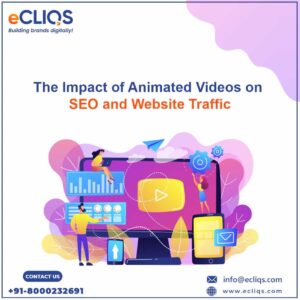
1. Engaging content for high viewing time:
Animated videos are engaging and convey information in the most creative way. In the world where the audience demands everything instant, animated videos play a great role in coping up with the instant world. As a result, search engines are highly likely to reward websites that have animated videos with higher rankings. The longer the viewers stay on your website, the higher ranking on the search engines.
2. Reduction in bounce rate:
High bounce rates appear when visitors visit your website and leave quickly. This is where the animation videos come into play. Many brands make welcoming videos which address the audience’s interest and keep the audience hooked to your website in the first glance hence reducing the bounce rate.
3. Enhancing backlink opportunities:
Visually appealing animated videos have a higher rate of being shared on different platforms and social media channels. When different websites link back to your videos or embed it on their pages, you will gain invaluable backlinks. Backlinks from authoritative sources play a significant factor in boosting your SEO rank. Animated videos therefore serve as a linkable asset for boosting your SEO as well as website traffic.
4. Boosting social engagement:
Social media platforms thrive on engaging content and animated videos are a great way of getting your audience hooked to your content. The more your videos are shared and engaged with on social media, the more the traction and more the visibility. This increased exposure leads to mass traffic on the website since curious audiences are more likely to visit your website to learn more about your brand and services/products.
5. Enhanced Mobile Experience:
Animated videos are best suitable for mobile consumption since they convey information effectively in a visually appealing manner. Since mobile friendly websites are favored by search engines, having animated videos that can be consumed quickly and offer an enjoyable experience can positively impact the SEO results.
Conclusion:
Having animated content into the digital marketing strategy can have a positive impact on SEO since animated videos are funny, engaging and bring a lot of traction. By keeping the visitors engaged, reducing bounce rate, enhancing backlinks, boosting the social media engagement and having an enhanced mobile friendly experience, your website’s authority and visibility increases.
Popular Website Trends of 2023
Many say that the trends in websites come and go so you don’t have to pay too much attention to them and not waste your time, money and resources!
One day a big bold typography makes a big impact and the other day small fonts and minimalistic designs amazes the audience.
However, a good website is something that does its job, promotes your brand, showcases your brand values and is a real reflection of who you are!
Of Course it has to be functional and meet the technical web standards as well as audiences’ expectations!
This is where the web designs come into play. They allow you to meet current expectations of the audience and make the website look worthy of your audience’s time.

Let us see what are the biggest trends to watch to stay on the top of your A game!
1. Interactive Websites:
Modern technology (including web browser support capabilities) has vastly improved. As a result, we can see how this trend is gradually maturing into something extravagant yet significant and becoming an essential component of website design, such as a slide-out menu or mobile-friendliness.
Creating an interactive experience for your user has a solid ground. This is what the market expects from you. Interactive content is more likely to engage a visitor than any static content!
2. Low-Code Websites:
Previously, building a website was all about hiring a developer, conveying your thoughts and then getting it done. The biggest problem being, the website always turned out to be different than you had thought as the developer had technical knowledge but limited business knowledge so while he was good at providing the required functionalities, he might not be that good at providing the required look and feel and the user experience. Also these websites took lot of time
But now tables have turned. Anyone having relevant experience on no-code builder applications like wordpress, shopify and similar tools can build a website using their drag and drop functionalities. Thus, now someone who understands business and competitors can help you build the website with an attractive look and feel and amazing user experience. In addition to this this can be built in fraction of time taken by a developer who is building from scratch
3. Immersive 3D World:
This style entails creating an imaginary environment with abstract and occasionally ludicrous features. It has a distinct attraction and a significant impact on consumers, enticing them to immerse themselves in a glitzy world where they can escape mundane routines.
These projects are typically visually heavy. They contain a slew of dynamic effects and interactive elements that allow viewers to interact with the environment. Some have audio backgrounds and video elements that are merged.
4. Gamification:
Gamification is another big trend to adopt in your website. It makes things easy to understand and makes it less boring. Gamification is usually advised for educational websites where there is too much knowledge and no one wants to read long paragraphs. Gamification comes into play here!
The best part of gamification is, it not only includes games but game-like elements , mechanics and features to your website.
5. Minimalism:
Not everyone desires a showy website with bright colors and quirky animations. As a result, one of the top web design trends for 2023 is minimalism. Minimalist designs employ limited color palettes and as few design elements as essential to convey the message.
Although choosing a minimalist aesthetic has various advantages, you must pay special attention to the general balance of each design, as a huge amount of white space makes it clear when something is out of place.
How to leverage influencer marketing for your startup?
The world is moving at an unimaginable pace and to keep up with that, startups are finding new unique ways of standing out. One such effective strategy has gained popularity in recent days, Influencer Marketing. With influencer marketing, startups get an edge where they can hope to stand out amongst their competitors and leverage the power of influencer marketing.
In this blog, let’s take a look at how influencer marketing can prove beneficial for your brand!
Understanding Influencer Marketing
Influencer Marketing involves collaborating with mini, micro, and nano influencers to build your brand presence, enhance growth and build trust with your customers.
Influencers can range from social media personalities and bloggers to experts and leaders. By collaborating with influencers who have a substantial amount of followers, you can help your new brand reach a wider array of audience and enhance your brand presence and capitalize on the influencer’s credibility and authenticity.

Ways to Leverage Influencer Marketing
1. Identifying Influencers
Depending on your niche, you can choose the influencers that suit the best for your brand and products/services. Conduct thorough research to find the relevant influencers who match with your brand values, target audience, and niche.
2. Build Authentic Relationships
Successful influencer marketing campaigns go beyond one-time transactions. Focus on building customer trust and leveraging influencer audiences to reach your target audience. Engage with them genuinely, and understand their problems and interests.
3. Co-Created Content
Collaborate with influencers to create engaging but original content which will not only attract your target audience but will keep them hooked to your brand and also resonates with the influencer’s followers. Whether it’s a sponsored blog, social media post, or video content, ensure that the quality of the content aligns with both your brand and the influencer’s personal style.
4. Give Creative Freedom
Influencers know their audience better and hence know what best works for them. Influencers need creative freedom to think and executive unique and out-of-the-box ideas. If you provide them with the freedom of execution, the content will be more likely to be liked by the audience since the influencer knows what works best with their audience. This approach not only allows the influencers to showcase your product originally but also enhances their credibility.
5. Host Giveaways and Contests
Influencer Marketing isn’t limited to a single platform. Explore collaborations of several platforms which include social media platforms, posts, blogs, articles, and even live sessions. Diversify your influencer campaign to reach a wider audience and build a community of the same interests.
Benefits of Influencer Marketing
1. Enhanced Brand Credibility
Influencers have already established their credibility and authenticity so partnering up with them can give your brand instant popularity and enhanced brand presence especially when their audience sees them endorsing your product.
2. Increased Brand Awareness
Influencers have the power to showcase your brand to a wide audience. This newly gained reach can help you bypass traditional advertising barriers and reach your potential audience who are genuinely interested in your products.
3. Improved Audience Engagement
Influencers often have an engaging and loyal fan base. This can help your product reach potential audiences who can positively engage with your products and share similar interests. When influencers promote your products, it’s likely to lead to a higher engagement level including likes, comments, DMs, shares, and click-throughs.
4. Cost-Effective
The traditional advertising budget often goes beyond the limits of the newcomers in the market. But influencer marketing has proved to be a boon to startups. Influencers usually charge based on their following and that can vary according to the category of influencers which consists of mini-influencers, micro-influencers, and nano-influencers.
5. Authentic Storytelling
Influencers are skilled storytellers who have a unique way of conveying your brand story with authenticity and reliability which attracts more audience since in today’s much falke world, people love to see what’s real! This storytelling approach resonates best with the audience on a deeper level making them more likely to connect with your brand.
6. Increased Sales
The follower base of influencers trusts them and when they endorse a product the likely hood of the follower base purchasing the product increases tremendously. Thus influencer marketing can lead to higher sales for the product
Conclusion
In conclusion, Influencer Marketing presents a startup with an incredible instant opportunity to grow its brand presence and connect with a wide range of potential audiences. The benefits of Influencer Marketing go beyond just numbers. They facilitate the creation of meaningful connections between your startup and the target audience.
Threads by Instagram
In today’s fast paced world, it’s important to stay connected with people who you share good memories with. Instagram, a popular photo and video sharing app has kept us updated with latest trends and a sneak peek into the lives of our near and dear ones. But, there arose a need for a more intimate and private way to connect with our close friends. That’s why they introduced “Threads by Instagram”!
This application is designed to help users share and communicate effectively and still manage to lead a private life. In this blog, we will explore the features and benefits of “Threads by Instagram”. So, stay tuned till the end.

Features:
1. Close Friend List: This app revolves around the concept of keeping our closest friends close. Close Friend List is a feature that allows you to curate a list of close friends with whom you share most cherished memories. By selecting a close friends list from the Instagram app, you can seamlessly share photos, videos and your darkest thoughts too!
Threads takes it further by bringing this list on the forefront making it easier to communicate with your inner circle.
2. Status Updates: One of the standout functions of “Threads by Instagram” is its automatic status update. Threads uses your phone’s location, motion sensors and battery level updates to provide contextual status updates. For instance, if you are “At Home” or “Low on Battery”, threads allows your close friends to know what you are upto without much of a hassle on your part. This encourages natural and real time interactions bringing you close to your friends.
3. Photo and Video Sharing:
Threads make sharing moments with your friends a breeze. With spontaneous opening of the camera to capture real time photos and videos, you can send photos and videos to your friends just with a tap.
With an option to add captions or stickers, your media becomes more engaging and relatable.
4. Messaging made Simple:
In addition to the spontaneous photo and video sharing, messaging as a central component is the cherry on the cake. Threads offers a simple messaging interface which focuses solely on your close friends. You can send text, react with emojis, share reactions to messages and send real time pictures to your friends through camera without having to leave the conversation. How cool is that?
5. Privacy and Control:
Instagram has placed a very strong emphasis on privacy and controls with Threads. Users have full control of their close friends list, allowing them to add or remove individuals from the list.
Benefits:
1. Authenticity: By focusing on close friends, you can stay closer by keeping yourself updated with all the live life updates of the people you love most.
Threads incorporate authenticity without the pressure of a wider audience.
2. Intimacy: The app provides a safe and intimate place for your thoughts to be shared with your close friends, strengthening your bonds.
3. Time Saving: Threads allows you to share photos and videos directly from the messaging so you don’t have to leave your conversation in half.
4. Contextual communication: The automated status updates provide context allowing friends to understand each other better without having to wait so long for updates.
Conclusion:
Threads by Instagarm is a powerful app that helps you keep your inner circle closer. With the fast moving world, we often lose connection with our close friends but not anymore. Threads by instagram allows us to cherish the past memories by sharing photos and also keep your loved ones updated!
Performance Max Google Ads – Its significance and important elements to optimize while running this campaign
What is Performance Max?
The Performance Max is a new sort of automated Google advertising campaign that employs Artificial Intelligence to display responsive advertising across the major networks: Search, Display, YouTube, Gmail, Discover, and so on.
To begin with these campaigns, advertisers must develop and structure their creatives before activating them using Google Smart Bidding based on the objectives of each advertiser.
When To Use Google Performance Max Campaigns
- Google recommends you use Performance Max when:
You have specific advertising and conversion goals: To get the most out of it, it is recommended setting SMART goals. - Your ads aren’t limited to a particular channel: If your advertising has limitations or constraints (e.g., a limited budget, time, a lack of resources, etc.) or were created for a specific channel, now is not the time to employ Performance Max. It works well for campaigns that allow for real-time adaptation.
- You want to take your keyword-based Search campaigns even further: Performance Max will enable you to reach even more individuals, resulting in more conversions.

Important Elements to Optimize in Performance Max Google Ads Campaign:
1. Campaign Objectives: By creating clear campaign objectives, whether they are lead generation, sales growth, or brand awareness, the campaign is structured in the right direction resulting in better outcome
2. Compelling Ad Creatives: Take efforts on designing visually appealing creatives to attract your target audience and leverage the power of visuals. This will not only attract your target audience but will keep your audience hooked to your brand. Don’t forget to tailor your message for your target audience to resonate with your brand and add a compelling CTA (call-to-action)
3. Audience Segmentation: With the help of google’s audience segmentation tools, refine your audience based on demographics, behaviors and interests. This will ensure that your ads are being shared to the audience which best resonates with your objectives.
4. Landing Page Optimization: The success or failure of performance max ads campaigns is not solely dependent on the ads you run or the visuals you make, landing page plays a crucial role too. You have to ensure that your landing pages are designed for a seamless user experience and relevance, and convey clear conversion pathways.
5. Monitoring and Refinement: Regularly monitoring the performance in your ad campaign will help analyze the data to identify trends, patterns and the areas of improvement.
Benefits of Google Performance Max Campaigns:
The main benefits of Performance Max are:
1. Access to the entire Google Network: Machine learning will provide the appropriate advertisements to the right people at the right time, taking your keyword-based search campaigns to the next level.
2. Automation: All aspects of the bidding and ad buying process are automated with Smart Bidding, and Performance Max will even build your ads for you depending on the creative assets you provided.
3. Audience signals: Allows you to instruct the machine learning algorithms to save time and maximize efficacy.
4. Better insights: Includes additional features such as Asset Audience Insights and Diagnostic Insights
5. Goal-focused campaigns: To help you achieve your marketing goals.
In a nutshell, Google Performance Max campaigns are designed to make your clients’ Google Ads campaigns easier to set up and to get those ads in front of more people, while also optimizing performance in real-time.

